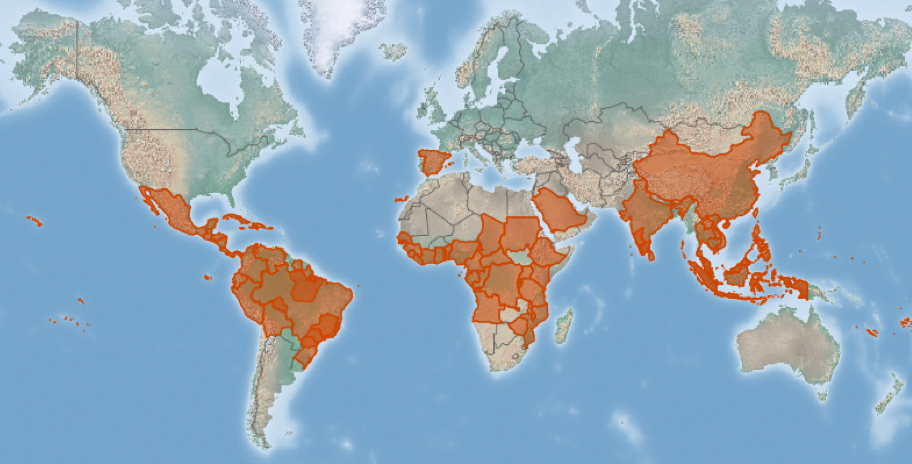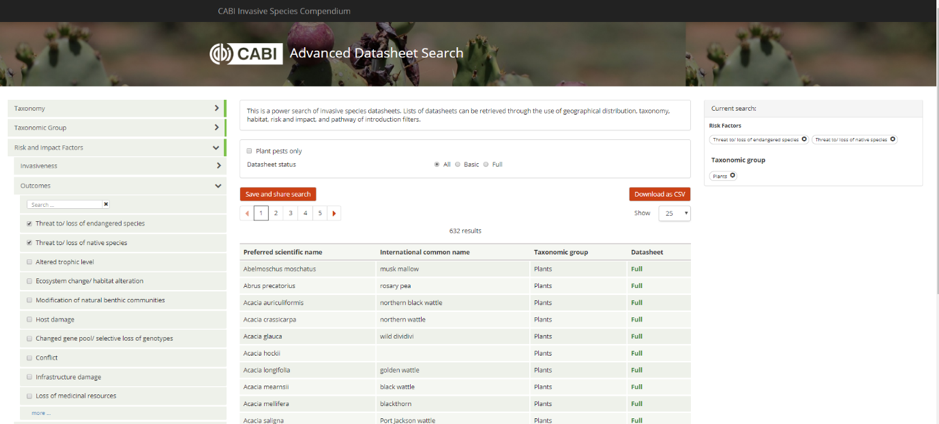
A new look for species distribution maps
Compendia datasheets now benefit from enhanced data visualisation of species distributions. It is easier to view the global distribution of a species, with polygons indicating where a species is present. National records are shown in light shading while subnational records are darker. In Compendia datasheets, CABI aims to compile data at the state, province or island level for large countries and those with detached parts. Enhanced filtering tools allow greater interactivity to view attributes such as extent, invasive, and introduced or native statuses and also additional datasets where available.
Enriched distribution and host data
Recognising the importance of up-to-date species distributions and pest-host relationships to Compendium users, CABI has prioritised these datasets for updating. During 2020, approximately 80,000 pest distribution records and over 20,000 records of pest-host relationships and were added to Compendia datasheets from peer-reviewed published literature and other authoritative third-party sources. To explore the new host lists, which now include references, please take a look at the ‘Host Plants and Other Plants Affected’ table on the Tuta absoluta datasheet.
CABI’s Horizon Scanning Tool and Pest Risk Analysis Tool draw on the Compendia datasets to generate lists of species that may represent a biosecurity threat. The on-going enrichment of the Compendia data allows users to generate more accurate and up-to-date species lists to support this work.
Some new ISC features – let us know what do you think!
CABI is always keen to receive feedback. In addition to the new distribution map display which has been applied across Compendia, the Invasive Species Compendium (ISC) now has collapsible datasheet sections to reduce scrolling through long sections plus filter and search options in most datasheet tables. Have we got this right?
A beta version of a new Advanced datasheet search has been added which provides filters for creating a list of invasive species based on taxonomy, broad taxonomic group, risk and impact factors, and pathways. The list can be used to access the datasheets that meet the selected criteria or download as a CSV file. Additional filters for distribution and habitat are in progress but feedback on the approach and your use cases would be valuable at this time.

Please email ISC@cabi.org with any feedback on this Compendium, it would be great to hear from you. These data and website enhancements have been made possible through CABI’s Action on Invasives Programme.
Extended invasive species coverage through funded projects
Recent projects funded by the US Department of Agriculture (USDA) have contributed a further 154 new datasheets on invasive plants of the Caribbean islands and 33 plant pathogens of concern to the US to the ISC. A small project was also undertaken to commission datasheets on invasive species threatening Hawaii, funded by the Coordinating Group on Alien Pest Species (CGAPS). Project work in the open-access ISC complements CABI’s other updating activities with the datasheets being shared across all relevant Compendia.
Pest Risk Analysis Tool enhancements
The PRA Tool is provided as an add-on subscription to the Crop Protection Compendium (CPC). Developed under CABI’s Action on Invasives Programme, gratis access has been offered to the National Plant Protection Organizations in 97 lower-income countries and its usage is increasing. The tool helps risk assessors and risk managers to conduct a PRA according to international standards using linked pest data from the CPC datasheets as a starting point. PRA reports can be created for individual pests or plant commodity pathways.
Various enhancements to the workflow were added during the last year but the major new features are:
- Flexible team working online in the tool and offline in MS Word
- Improvements to the handling of the commodity pathway pest list: for example, a risk assessor can now exclude selected pest groups if not of concern and also document rapid assessments to focus on the pests needing a more detailed risk assessment.
- Creation of a regulated pest list so that pests that are already of quarantine concern are flagged up in pathway pest lists
- Import of data directly from the CPC datasheet into the identity, distribution and impacts sections of PRAs
A description of the tool and details of updates are included in the open-access Help page. For enquiries about this tool, please contact PRA@cabi.org.
General enquires and feedback can be sent to the Compendia Programme team at compend@cabi.org. It would also be great to hear about your projects involving Compendia data!
3 Comments
Leave a Reply
Related News & Blogs
Invasives Most Read 2019
As 2019 draws to a close, we have crunched the numbers and pulled together the year’s most read articles. Plus some firm favourites. Fall armyworm continues to be a popular topic for our readers and this year, blogs on biocontrol efforts to control the…
20 December 2019



Separately phytosanitary significance is required to be included. But all the requirements for conducting PRA was designed in such a way that it will help us to conduct PRA in a easier way. Certainly the specialists can update it time to time.
Excellent stuff on the updates
It would be interesting to hear other views on whether it is appropriate for CABI to include regulatory status information such as quarantine pest listing in Compendia. So far, the PRA Tool provides an option for a risk assessor to manually create and update a list of regulated pests which can be shared with team members working together on PRAs.